An interview with Mike Nelson on architectural sculpture & the making of place
Mike Nelson is an internationally regarded artist deeply interested in the materials, narratives & history of place. He uses whole chunks of architecture in projects which vary in scale from small photographs to urban-scale interventions. Twice nominated for the Turner Prize & representative of Britain at the 2011 Venice Biennale, Mike Nelson is an artist who more than any other works in an architectural manner.
When Mike Nelson mounted his retrospective at the Hayward Gallery (see 00086) the artist reconstructed some of his immersive earlier works. Interested in creating uncanny spaces from the detritus of capitalism and built worlds, his inhabitable sculptures that take visitors out of the gallery setting and into other-spaces feeding off sci-fi, fiction, past political hopes, and distant geographies led to two Turner Prize shortlistings and representing Britain at the 2011 Venice Biennale.
![]()
fig.i
At Fruitmarket, a gallery in Edinburgh, Nelson has created a new immersive for the first time in a decade (save for a smaller, though no less intriguing, project for Matt’s Gallery, see 00020) and it forms one part of a three-element show taking over the lower and upper spaces of the older, white-walled gallery, and also the Warehouse space. Separate from the main galleries by the excellent café and shop, the Reiach and Hall Architects-designed Warehouse inhabited the space left by a former nightclub, stripped back into an industrial, double-height room held by a raw, revealed steel framework. When Fruitmarket director Fiona Bradley first planned expansion into the space, she approach Mike Nelson to visit to get his thoughts on the possibilities, materiality, and how history could be present. His exhibition, Humpty Dumpty, is his first solo show at Fruitmarket, developed from those discussions but initiated by Bradley after Nelson’s 2011 Venice presentation that incorporated elements of his earlier works at the 2003 Istanbul Biennial.
Nelson re-uses not only materials, but ideas in his practice. Turkey recurs again here with photographs the artist made of Mardin for the city’s 2nd biennial, where he presented a map of his observations of the city physically ruptured as it upgraded itself, revealing its history in the process. Above it in the upstairs gallery, Nelson presents a series of new sculptures made over the last two months in situ, utilising materials found across Edinburgh, glass from a previous Fruitmarket show, and photographs he made in 2014 at the Heygate Estate in south London, an Elephant and Castle post-war slab-block housing scheme then undergoing violent demolition and now completely disappeared underneath a neoliberal reshaping of London that has removed not only architecture but communities.
![]()
figs.ii-iv
While making these sculptures, Nelson set up shop in the Warehouse, which he named the “engine room” for the duration. Here he not only made the sculptures and printed large prints but created a beguiling architectural immersive work formed of the interiors of two of the Heygate apartments. Originally working with Artangel to create a large-scale ziggurat sculpture from several of the social homes after residents had been forcibly evicted, the project was cancelled in the face of local opposition with accusations of artwashing and insensitivity to the lives that had lived in the homes, and indeed neighbours observing the art installation whilst undergoing their own eviction.
Nelson’s installation here is formed of the interiors, and some artefacts from, two of those Heygate flats. A decade passing may have softened suggestions of appropriation of another’s lived experience, but these are still haunted and sombre spaces. In amongst the debris and objects are food containers and items with Turkish writing on, a knowing intermingling of architectural upheavals across different territories and times and their impact upon residents and societies within, as well as one of many strands interlinking the three components of Humpty Dumpty.
In this exclusive interview, our editor Will Jennings started off by asking Mike Nelson about the unrealised Artangel project for the Heygate Estate:
This interview was originally published in July on A Deeper Recess, the reader-supported newsletter from recessed.space that runs parallel to the free news update bulleting, The Recess, delivered straight to your inbox.
Please consider subscribing to A Deeper Recess to help support independent writing on art and architecture, more details available HERE.
![]()
Also, these machines look like post-war British modernist sculpture. And these machines are partly what made modern sculpture possible. You've got this circle of design and forming, of sculpture defining design. And there was a doubling absence of the figure as well. A lot of them reminded me of the British Museum’s lower gallery sculptures of creatures, and yet there was also an absence of the people that worked the machines. The whole work conjured up a heady mix. And of course, there were, it also just looked like a warehouse with stuff in storage. It was a lot of fun making it – but it was very stressful, I hated the buying of all the stuff.
![]()
![]()
![]()
The idea of this demolished building with incredible political meaning in South London, and then an incredibly historic, ancient, hilltop city being rebuilt. Everything that I witnessed in Mardin was very transient, very passing, and soon to be buried – there’s a photo there with a trench that has been filled in. So, a sense of things being buried, things being unseen, things being demolished, things built on top, one coming up, one going down. It's both politically underpinned, both complex, these Mardin photos could be ambiguous, because what they were providing – water, drainage, the internet – was really positive, but one couldn't help but think, that nothing in that region of Kurdish, southeast Turkey is without its complications.
![]()
![]()
![]()
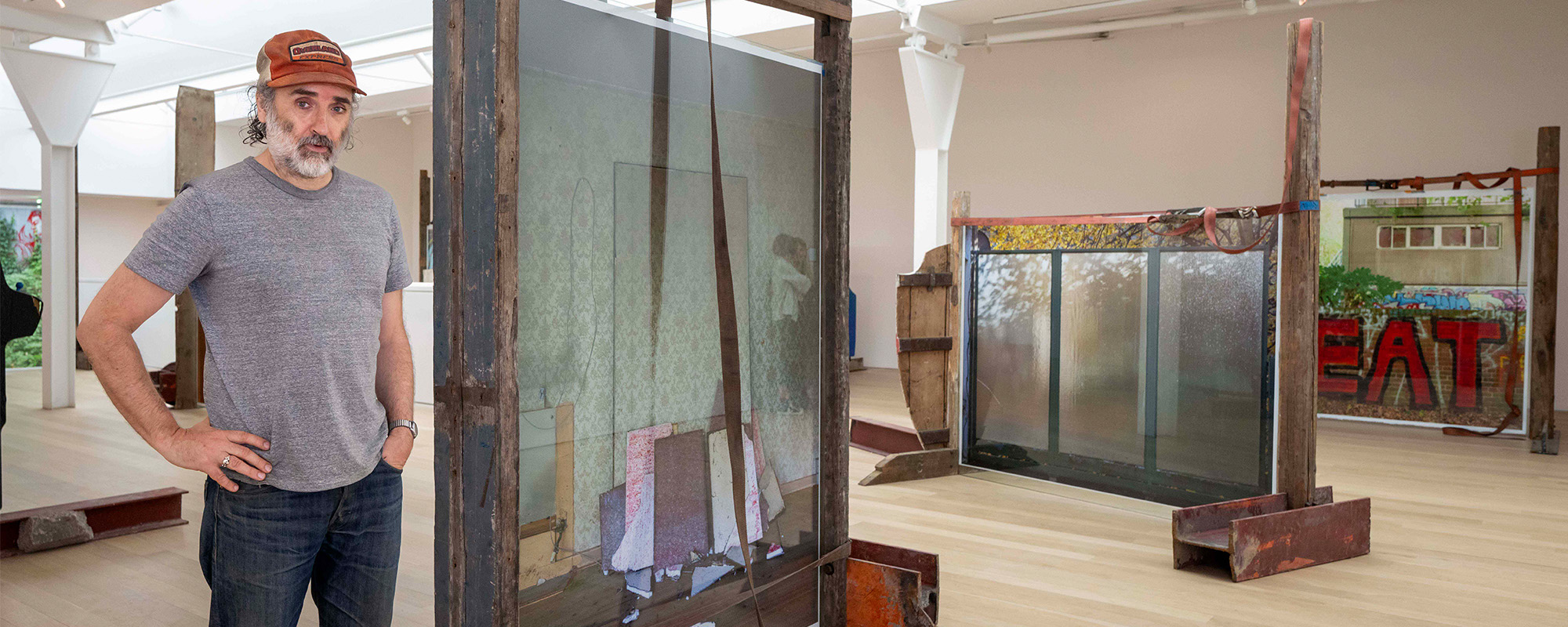
fig.i
At Fruitmarket, a gallery in Edinburgh, Nelson has created a new immersive for the first time in a decade (save for a smaller, though no less intriguing, project for Matt’s Gallery, see 00020) and it forms one part of a three-element show taking over the lower and upper spaces of the older, white-walled gallery, and also the Warehouse space. Separate from the main galleries by the excellent café and shop, the Reiach and Hall Architects-designed Warehouse inhabited the space left by a former nightclub, stripped back into an industrial, double-height room held by a raw, revealed steel framework. When Fruitmarket director Fiona Bradley first planned expansion into the space, she approach Mike Nelson to visit to get his thoughts on the possibilities, materiality, and how history could be present. His exhibition, Humpty Dumpty, is his first solo show at Fruitmarket, developed from those discussions but initiated by Bradley after Nelson’s 2011 Venice presentation that incorporated elements of his earlier works at the 2003 Istanbul Biennial.
Nelson re-uses not only materials, but ideas in his practice. Turkey recurs again here with photographs the artist made of Mardin for the city’s 2nd biennial, where he presented a map of his observations of the city physically ruptured as it upgraded itself, revealing its history in the process. Above it in the upstairs gallery, Nelson presents a series of new sculptures made over the last two months in situ, utilising materials found across Edinburgh, glass from a previous Fruitmarket show, and photographs he made in 2014 at the Heygate Estate in south London, an Elephant and Castle post-war slab-block housing scheme then undergoing violent demolition and now completely disappeared underneath a neoliberal reshaping of London that has removed not only architecture but communities.
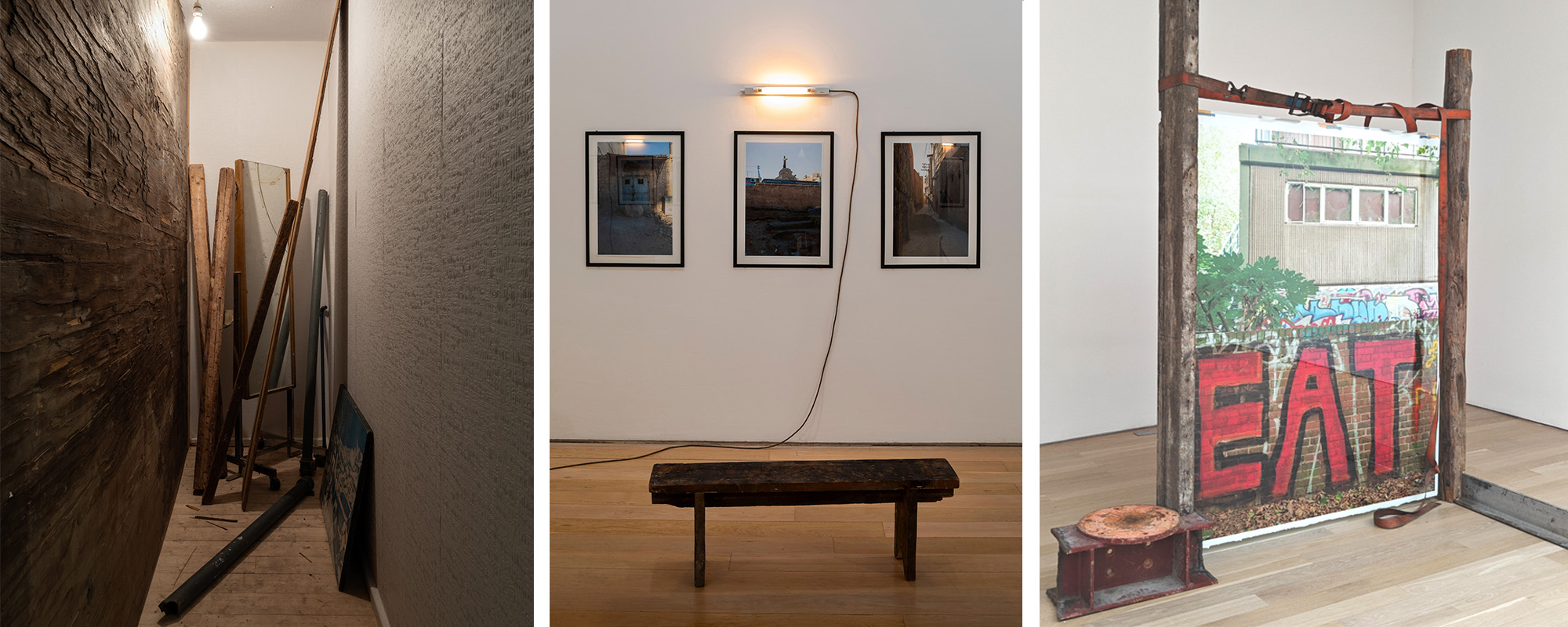
figs.ii-iv
While making these sculptures, Nelson set up shop in the Warehouse, which he named the “engine room” for the duration. Here he not only made the sculptures and printed large prints but created a beguiling architectural immersive work formed of the interiors of two of the Heygate apartments. Originally working with Artangel to create a large-scale ziggurat sculpture from several of the social homes after residents had been forcibly evicted, the project was cancelled in the face of local opposition with accusations of artwashing and insensitivity to the lives that had lived in the homes, and indeed neighbours observing the art installation whilst undergoing their own eviction.
Nelson’s installation here is formed of the interiors, and some artefacts from, two of those Heygate flats. A decade passing may have softened suggestions of appropriation of another’s lived experience, but these are still haunted and sombre spaces. In amongst the debris and objects are food containers and items with Turkish writing on, a knowing intermingling of architectural upheavals across different territories and times and their impact upon residents and societies within, as well as one of many strands interlinking the three components of Humpty Dumpty.
In this exclusive interview, our editor Will Jennings started off by asking Mike Nelson about the unrealised Artangel project for the Heygate Estate:
This interview was originally published in July on A Deeper Recess, the reader-supported newsletter from recessed.space that runs parallel to the free news update bulleting, The Recess, delivered straight to your inbox.
Please consider subscribing to A Deeper Recess to help support independent writing on art and architecture, more details available HERE.
You have seen London change over the last twenty years. I know your work is interested in not just one place, but a layering, palimpsests and a coming together of places, but London always feels central in your making, your studenthood, and now Professorship at Kingston School of Art.
It was an ongoing work I was making with Artangel, and we went through several sites before we ended up with Elephant and Castle – originally it was going to be Bolsover Street and the old orthopaedic hospital, an amazing old building – and originally it was to be a burial mound, a building that buried itself back into itself, so more like a big long-barrow of debris.You are interested in this about history – with ancient history, with modern history, and how it can collapse into one.
Yeah, very much. In fact, I've got an old concrete bunker-like water tank that's buried in earth, like a post-war burial mound, and it’s between two Bronze Age burial mounds. It's very unusual.What do you mean by “I’ve got it?” Because, you collected places to store all your objects, your work is scattered into storage.
I actually own it, it’s next to my storage barn in Wales. It’s potentially an artwork in the making. It's almost an artwork how it is now. It was for sale when I was trying to make the burial mound with Artangel, that's why I went to see it, because it was a readymade, like a post war concrete structure, like a feeder tank between two Bronze Age burial mounds which are ancient monuments – I don’t know how the water board ever got to build this thing right in between!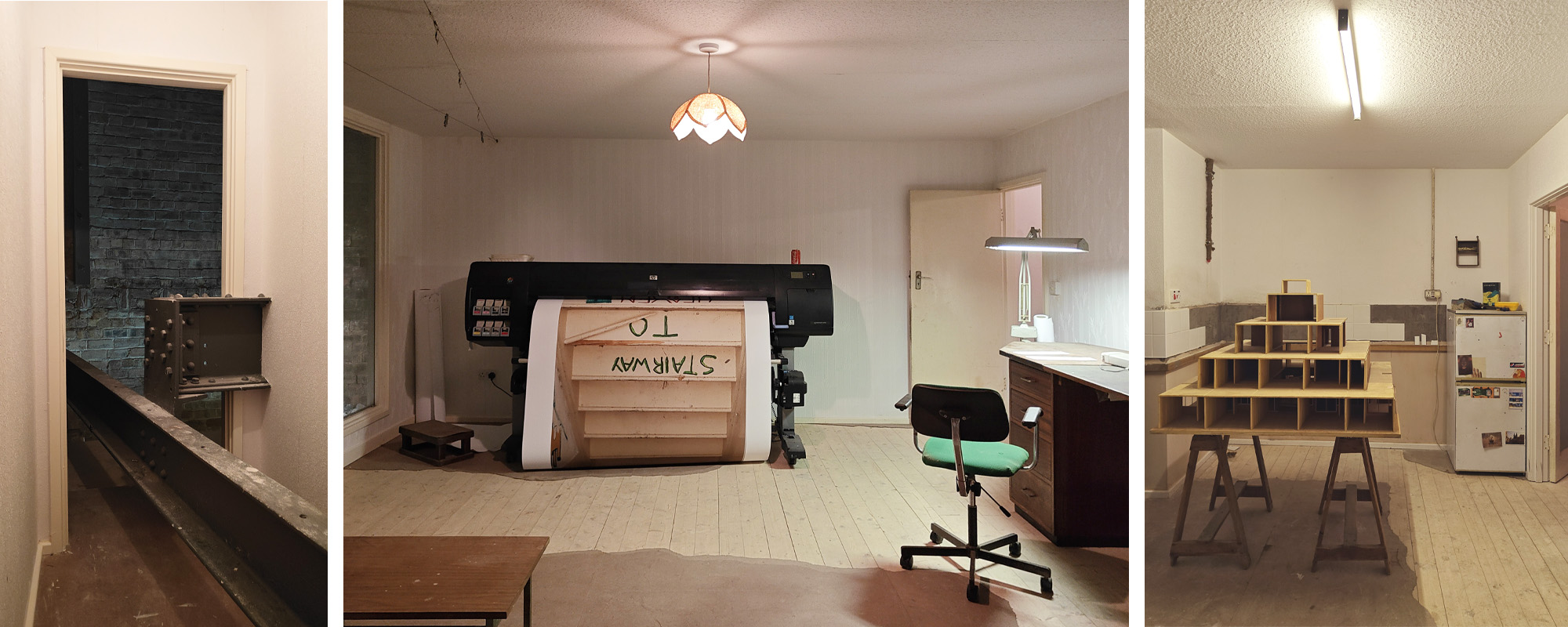
figs.v-vii
But it does speak to this idea of the junction you're interested in. In the upstairs gallery here at the Fruitmarket you have arcade machines shoehorned next to historic timbers which have traces of stickers and markings on. Is that to create a new third connection? What is that join about?
Well, there's a sense of trying to invoke this building. There is actual construction in the Warehouse, with one-to-one scale printing, with this printer that is on the point of obsolescence, just like how the flats were built, and then there’s a desire to try and make the images stand up between glass, sandwiched between the old timbers. The old timbers came from demolished buildings, both places of my own construction – from the British Pavilion exhibition in Venice, 2011, but also from buildings in Edinburgh. Then it’s all held up with bits of steel from the old Royal High School.A building which itself went through histories. It was going to be a centre of Scottish politics, and now it's going to become the National Centre for Music. It's had many other stories, unlived stories.
Yes, those girders are from the re-imagining of it in 1977 to 1980, when they were planning the first Scottish Assembly. But then the referendum in 1997 happened, so it was never used. It has an interesting backstory there as well in a material sense. You wouldn’t know unless you know, but for me it makes it interesting.The materials contain this for you, not just their own lived and unlived stories, but ones which you now lay onto them. I'm thinking of The Asset Strippers, your 2019 Duveen Galleries Commission in Tate Britain, which for me was kind of post-Brexit reimagination of the Great Exhibition – tell me what these piles of materials and their stories were about.
The thing about the Duveen is that it was conceived as a monumental sculpture gallery to sort of rival, from my perspective, the British Museum’s lower galleries or the Cast Galleries in the V&A. At that point, I thought “well, what am I going to make?” You know, “how do we make monumental sculpture that speaks of Britain in 2019?” What do we make it out of? Where do we find this material? Years ago, there were scrapyards and junkyards, but you can't even go into them anymore, you know, you can't walk into half of these places. But it’s all on the internet, of course, so then I saw these liquidation auctions. I thought, “I hate this, but it's interesting,” and then we started spotting all these companies getting liquidated at the tail-end of British industry, and everything was being sold off. And so I thought that if we bought enough of this stuff, we could build monumental sculptures out of it, stack it into structures that are strong enough to take the weight of the objects and the machines.Also, these machines look like post-war British modernist sculpture. And these machines are partly what made modern sculpture possible. You've got this circle of design and forming, of sculpture defining design. And there was a doubling absence of the figure as well. A lot of them reminded me of the British Museum’s lower gallery sculptures of creatures, and yet there was also an absence of the people that worked the machines. The whole work conjured up a heady mix. And of course, there were, it also just looked like a warehouse with stuff in storage. It was a lot of fun making it – but it was very stressful, I hated the buying of all the stuff.
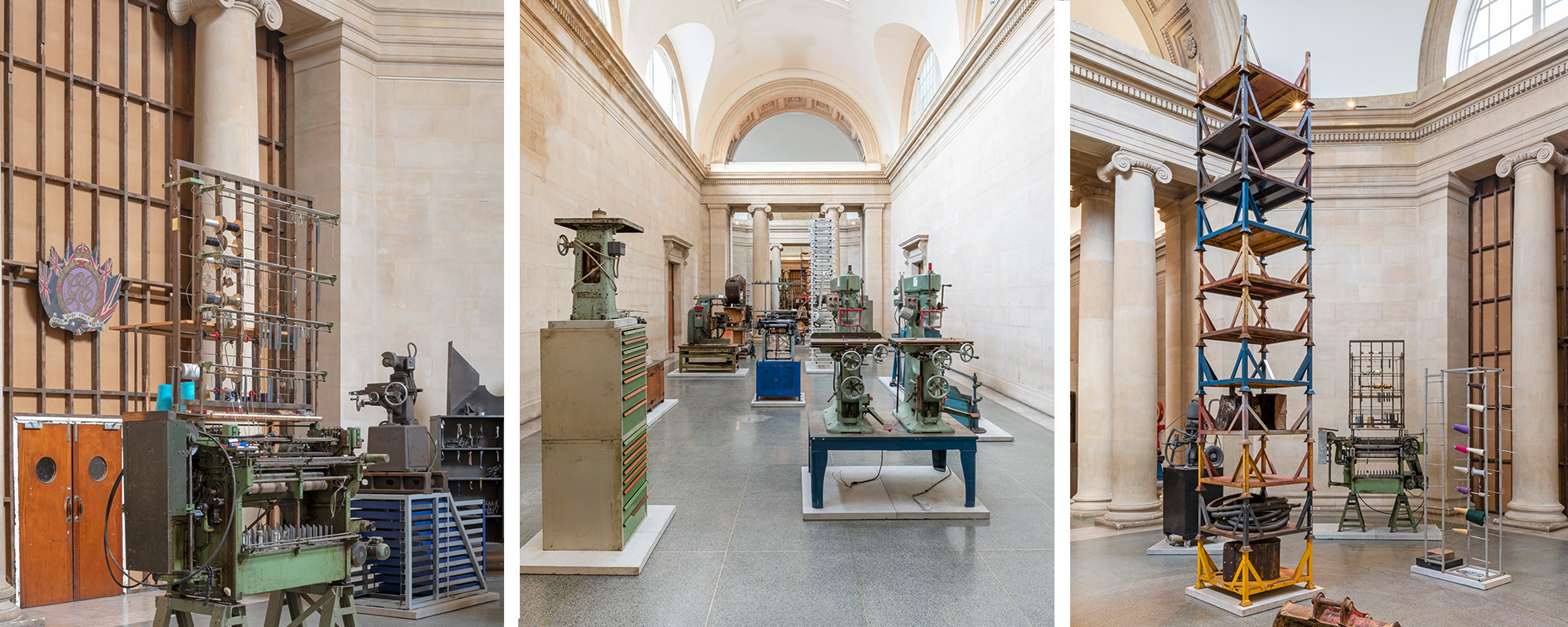
figs.viii-x
You hated it because of the loaded nature by which it came to be at auction, the liquidations?
Just being on auction sites is stressful because I’d have to find an auction where there were probably at least ten things I wanted. Otherwise, there was no point, because I’d have to send a lorry to pick it all up and if getting a lorry, I might as well pick up ten things – there’s an economy of scale. So, then I had to start bidding. And all the auctions go at different speeds, I had to keep an eye on all of them.Was there any sense of sadness these materials were carrying, you know? These objects of often Northern manufacture brought to London and put into a temple of culture.
They were not all from the North. There was stuff from the Southwest, Wales, Scotland, a lot from the Midlands. One of the main supplies, the best stuff actually, came from a factory where I was born, Loughborough. They were electrical engineers. My cousin worked there, my uncle worked there, and friends parents worked there – it was one of the big employers. So it was quite personal in a way. And I wanted knitting machines in because that's what my dad worked on years ago. He was a mechanic on knitting machines, my grandfather was the shop floor manager in the factory, my mum was secretary to the boss, my godmother was the secretary to my grandfather.Knitting speaks right back to the very early days of that looms and mills of industry that you're talking about. But, it also speaks to what has replaced it, the consumption and digital industries that we live in now. Here at the Fruitmarket, in the sculptures upstairs, you include arcade machines that perhaps speaks to this post-Industrial landscape. One of them has the back removed, and normally we don’t get to see inside these machines. They are normally objects of allure, aura, and magical escape, but we see it’s nearly totally empty!
And it's next to a big pile of ripped out plumbing from the estates, the gubbins and the interiors of everything.The gubbins of post-war housing are a bit different because such architecture, such as the construction you have put together in the Warehouse space – and indeed the Turkish properties that are surrounding us in this ground floor gallery – are all solid, nothing is there which doesn't need to be there. There's an economy of function and scale, whereas the arcade machine, and maybe also the neoliberal age it might represent, is one of image, presentation, magic. Is your work political in that way? Your practice covers these few decades of British transformation, from the end-of-industry to whatever we're about to get ourselves into.
Yes, for certain. I think it's hard not to be political to some degree. Obviously, I'm an artist, so my main interest is in formality, but of course there are different structures in place – there are structures of prose, language, and then there are structures of meaning and the instigation of it in terms of the story or concept. Ultimately, the best bits of fiction are those that reflect on all of these. To be beautifully crafted, but also open up a story for those visiting, reading, or looking at it.Upstairs, there is a small reading room and in it is a copy of the book you compiled for the Institute of Contemporary Arts’ 2001 Turner Prize exhibition. Inside, there is a lot of fiction – J.G. Ballard, Franz Kafka, H.P. Lovecraft, Jorge Luis Borges – and when it’s opened, the first page looks like it's of a different book to that on the cover, and then another. There’s something here about carving a journey for the reader, and of fictions within fictions. But, also, the novels you included extracts from are political – like good sci-fi is!
Yes, for certain, but in the end they're primarily fiction, literature. Doing a show here was quite difficult, it’s a complicated space to navigate because of the way it's broken up by the café and they're not particularly odd spaces.Director of Fruitmarket, Fiona Bradley, started the conversation with you years ago, after your work for the British Pavilion at the 2011 Venice Biennale and then spoke to you again ahead of the transformation of the Warehouse space. So, it’s a space that’s been present for you, and in your head, for quite a while!
It’s been in my head for a while, yes. The Fruitmarket always gets a good audience. It's nice that people might get off a train and, because it's café, come in even though they might not have been to an art exhibition. It's free, but the spaces are difficult to navigate, so I was always trying to work out a way a show could work. I think that the addition of the Warehouse space opened it up a lot for me – and then we had this idea of building the show in the space over two months – closing down a whole gallery for two months would be difficult, but closing down the Warehouse space was possible. So, I have been in there building it all for two months.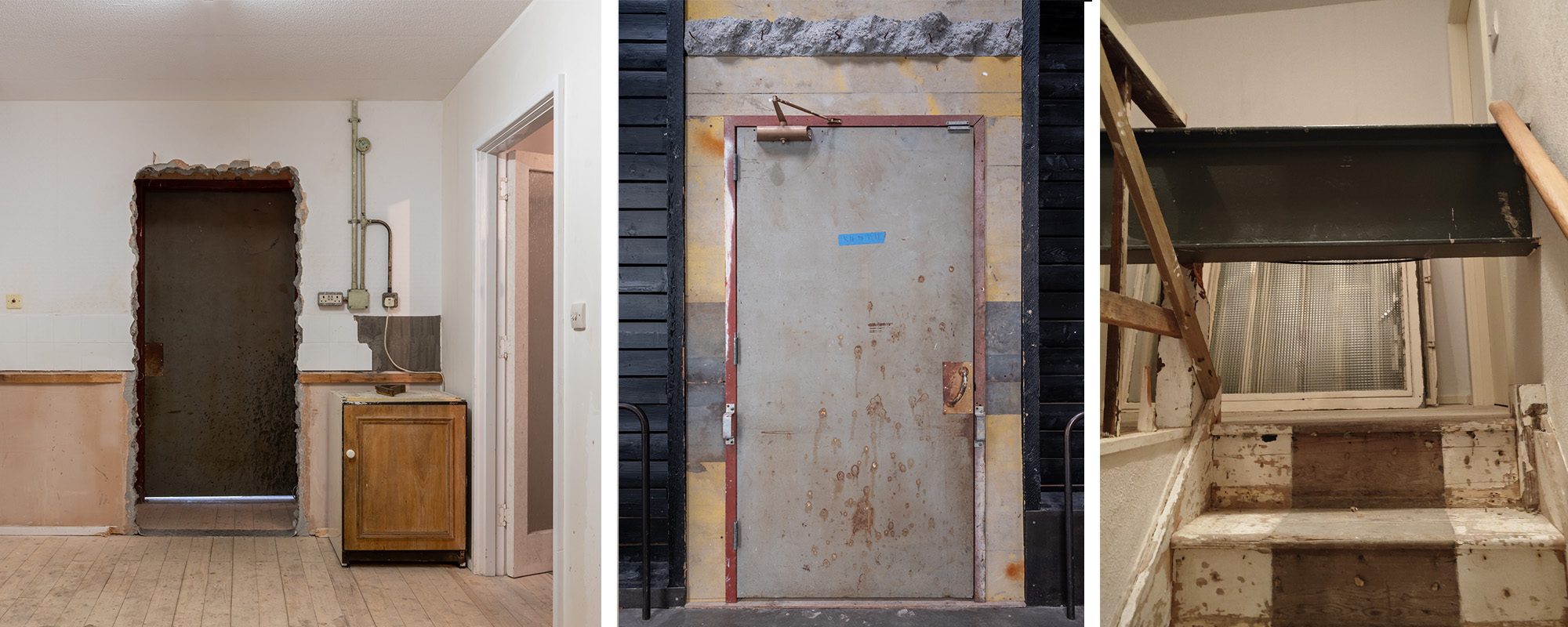
figs.xi-xiii
You’ve been in there, and you called it the Engine Room, but it’s also been a space where you have been making, and printing, and producing, and building.
The Warehouse work is a relatively modest construction, but it still takes its time.And it takes you back to the experiential element of your practice. I have never seen Coral Reef from the outside, but from the inside it seems enormous. It’s impossible to really know how much space it takes up, and even though I studied, worked in, and teach architecture, it’s hard to work out the actual space of it. In the exhibition info, you talk about Jorge Luis Burges and the idea of the map, and it is a kind of built map, but one that never reveals the inhabited territory. It’s a kind of dis-location, and it’s something you are interested in here – from the very first door from the corridor into the Warehouse space, which has “R16 to R17” written upon it, the visitor doesn’t know where they are going, they go in, then immediately there’s another doorway threshold…
Yes, exactly. Straight through, and then through the back wall of one of the flats, and then through another wall of another flat. And at the end, the model, of what we were building on the Heygate Estate – we were five weeks in on that when it was pulled, part of the building had already come down.With such an installation, what is it you want people – perhaps especially these non-art visitors you mention – to experience: a sense of dislocation, the uncanny, fear?
With those early pieces, and this shares a relationship to them too, I always found it remarkable that all these objects matter – the specific screws, hardware, nuts, bolts, timber, the objects, the acrow props, the windows… they all have to come together, almost like a language, into an order, to somehow, conjure something, somehow. I think when those works succeed it's a strange sort of moment, almost like a glitch in reality. I think it's that combination of a space constructed that never should have been there, like it's been constructed just for you to walk into, combined with some sort of social or political commentary. It can give almost a kind of hallucinogenic glitch in terms of reality, almost akin to a sort of drug or fervent religious belief. I think that's when they succeed the most, and they don't always do it, and they don't do it for everybody, but occasionally for somebody, there's this sort of “What the hell is this? What am I in? What the hell does this mean?” And, of course, we should be thinking like that more often in life.How do you mean? That we are too set in our ways, that our path is proscribed, that there’s an order?
Yes, in the world and what goes on…We need more glitches? The new Adam Curtis series, Shifty, talks a bit to that and a sense of cultural unease. It covers the same period of British history – from Thatcher to Blair – that perhaps your work considers, and something rupturing slightly. There is a moment in your Warehouse installation that definitely presents as a glitch – at the deepest part of the plan there is a domestic staircase, but at the top huge industrial girders cut across it. It makes the visitor wonder which came first, did some new construction interject or was this big industrial metal somehow left inside a new building.
Yeah, it's a nice moment to end our thoughts somehow. It’s slightly Magritte, sort of a boulder in a room, isn't it? You don't quite know what is – what's more real, the room or the boulder? The combination brings both into question.And if anyone climbs the stairs, it becomes a physical obstruction, it's the end.
You can look around the corner and one comes out like a bull’s head around the corner and it comes through the door frame, which is rather nice.Spatially, it seems complicated. Do you come into a project like this with architectural drawings, or do you have an idea and then with your team see what fits?
This is pretty much built on the floorplan of the Heygate Estate, of two flats. The windows are a little different, they’re from my house in London. They were taken out a few years ago and I kept them, they’re lovely old Crittall windows, but not very environmentally sound these days – and I had plans to make a sculpture from them, but I never used them so they came in handy here. So, the floor plan is pretty much laid out, but shifted skew-whiff, and you came in through the side of the third flat – the first sliver is a third flat and then you’ve got one flat, two flats. They were all built of good concrete slabs to some kind of weird Jesperson system. A house of cards, a concrete house of cards.Which is why, with the nearby Artangel project that happened earlier in 2008, Seizure by Roger Hiorns, when it finished it could be packed up and taken away, eventually to Yorkshire Sculpture Park.
Yes, that was the Aylesbury Estate. It's funny how the politics changed so much, so fast. It was so complex, The Heygate. To make this burial mount I wasn’t looking at public housing at all, I was looking back at things that represented the period. So The Heygate was perfect in many ways, but I knew it'd be so emotive. But actually, when they offered us that low rise block in The Heygate, it was kind of perfect in many ways, because the formality of it as well was that it could actually be access – part of the problem with a lot of the buildings we had looked at before was that we couldn't get diggers around, and then people wouldn’t see it from a distance either, whereas with The Heygate you would be able to see from a distance.But with such places, they're not just materials and objects. The politics is inherent from their construction but also from their demolition – with The Heygate Estate, the whole of phase one was sold offshore, those who were removed…
They were sent miles away!They were sent all over the country, which broke up communities. And they were given first refusal on new flats, but those started three or four times the price of the ones that had been compulsory purchased from them. So, how do you don't treat them – I know you don't treat them solely as materials without their history, but it can be an ethically dubious place, and maybe today it wouldn't even get as far down the project as yours did, because the politics around it would be so present.
In the end, I suppose it was a brutal work for a brutal situation. It necessitated that. The strange thing, when it was cancelled, I suppose, it was actually done at the bequest of the head of the Council, and it was because he was getting a lot of bad press.Well, he carried on getting a lot of bad press, as the council did, for their relationship with the developer Lendlease.
Well, exactly. But very little was being reported in the papers, and after my project closed the gates closed, there was no access to the site, the fences went up, you couldn't get anywhere near it, and I think I had it gone ahead, the voices that piece that could have provided, and the access to the site it would have provided, would have been very useful to the cause of the community. So I found it quite sad, because I think stopping it really benefited the people that sold the site off.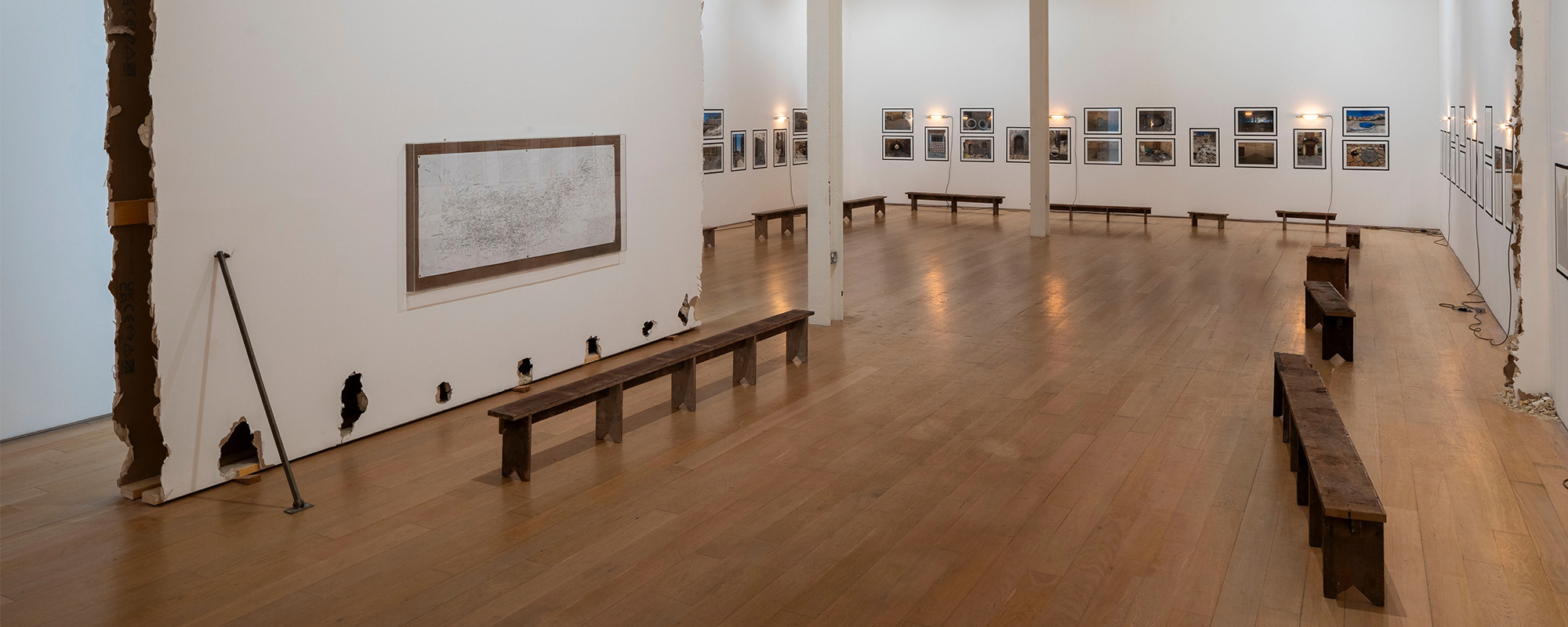
fig.xiv
Within this exhibition. Obviously, The Heygate Estate in South London is present, but another place present throughout is Turkey. We are here sitting in the Fruitmarket’s lower gallery with a display of photographs of Mardin in southeast Turkey. Perhaps your relationship with Turkey started in 2003 with your work MAGAZIN for the Istanbul Biennial, some of which was then re-used in your Venice Biennale project?
I first went to Turkey in 1987, then in 1992, and then obviously did the Istanbul Biennial in 2003. Sometimes cities or countries become like markers of your life as well, you return back and they change, you change, and they reflect back your own life. In many ways, Turkey is one of those places, and I find it really interesting.Because of where it sits in Europe, both East and West?
First of all, because of my own history of having travelled there. And that was purely accidental, I’d never been…Wait, what was the accident that took you to Turkey?
Ah, my old girlfriend was going there, so I went with her. She was travelling, so we spent a couple of months going through Eastern Turkey, because she'd done been to the West before, while I was at university, then I joined up with her and went to the East. I'd never ever been… I mean, I'd been on French exchange before, but that was it!It was a little different to the French exchange?
Exactly! It was kind of incredible, basically an incredible country, the geography, the politics, the history, sort of like also in another Imperial country, like Britain, and one that perhaps we didn’t know so much about, I suppose, obviously we talk about our own empire.The idea of this demolished building with incredible political meaning in South London, and then an incredibly historic, ancient, hilltop city being rebuilt. Everything that I witnessed in Mardin was very transient, very passing, and soon to be buried – there’s a photo there with a trench that has been filled in. So, a sense of things being buried, things being unseen, things being demolished, things built on top, one coming up, one going down. It's both politically underpinned, both complex, these Mardin photos could be ambiguous, because what they were providing – water, drainage, the internet – was really positive, but one couldn't help but think, that nothing in that region of Kurdish, southeast Turkey is without its complications.
And the histories which are being unearthed or ruptured.
It was an incredible place and these were all taken over one week. I had just built a show in Berlin, and I flew straight from Germany with my bag of tools and camera, then saw what was kind of going on in the city. It was a small budget, just “here’s a room, here’s a flight” and no fees, no budget to make anything, so I asked them to print me out a map of the old city, and then I just went around marking every moment that you see in these photographs. I never showed the photographs then, though.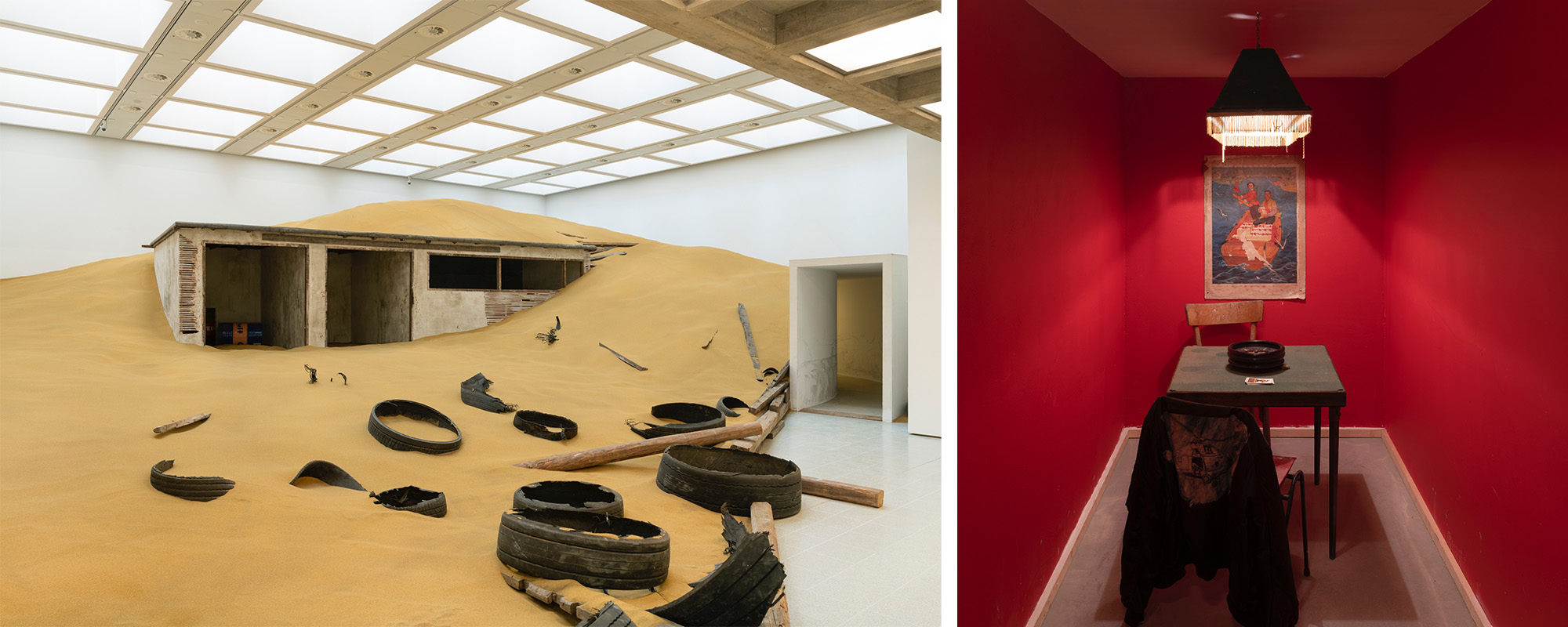
figs.xv,xvi
This speaks to your interest in the archive. For your retrospective at the Hayward Gallery, the first room encountered was one of storage, and you have various storage buildings in different places. And here, there are maps, but also in the Warehouse there is a 1990 horse racing calendar on the wall, which is another kind of archival system. What happened?
That’s from the Heygate Estate. And in fact, if you look at the cutting table in the room next door to it, there’s a photograph of it in the Heygate. There are a few things from when we were doing the Artangel work that I that I kept, from just rubbish stuff from the semi-demolished flats.In the Warehouse you have constructed a lot of architecture, upstairs you have created sculptures from architectural elements, but in this photographic gallery there is only big architectural gesture – you have cut out a huge dividing wall and moved it to block the entrance of the space. Perhaps easy on a drawing, but I guess a lot of labour?
Oh, it was alright! I just got up there on a ladder and chopped it out with an axe! It was a really badly built wall, but I didn't want it there as I think it really is a nicer space open like this and I needed to block off the entrance to control the light. Also, I made a work in Edinburgh in 1999 called To The Memory of HP Lovecraft, about a beast that ate the walls.That work was made for Collective gallery, then remade for the Psycho Buildings exhibition at the Hayward Gallery in 2007.
Collective, yes, and it was nice to make a reference back to that work.We talked about the arcade machine and the materials, but this is an exhibition formed of three parts: and in the upstairs gallery you have created sculptures, which are quite formal in a way.
I kept them quite formal, yes. Originally, I was going to show all the rest of the prints in there as well – there are another 50 images of the Heygate Estate that we printed on the machine which were going to go onto the walls. But then the gallery showed this glass to me, left over from a recent Barry Le Va exhibition here, and said “you can have all this glass, can you do anything with it?” I woke up one night thinking that a version of Duchamp’s The Large Glass might be quite nice, so I started thinking about that idea of trying to invoke a building by building it, then trying to invoke it by printing it.All kind of like Borges’ maps of replication.
Yes, and I wanted to make them stand up, so these images are like held in these 18 sheets of glass.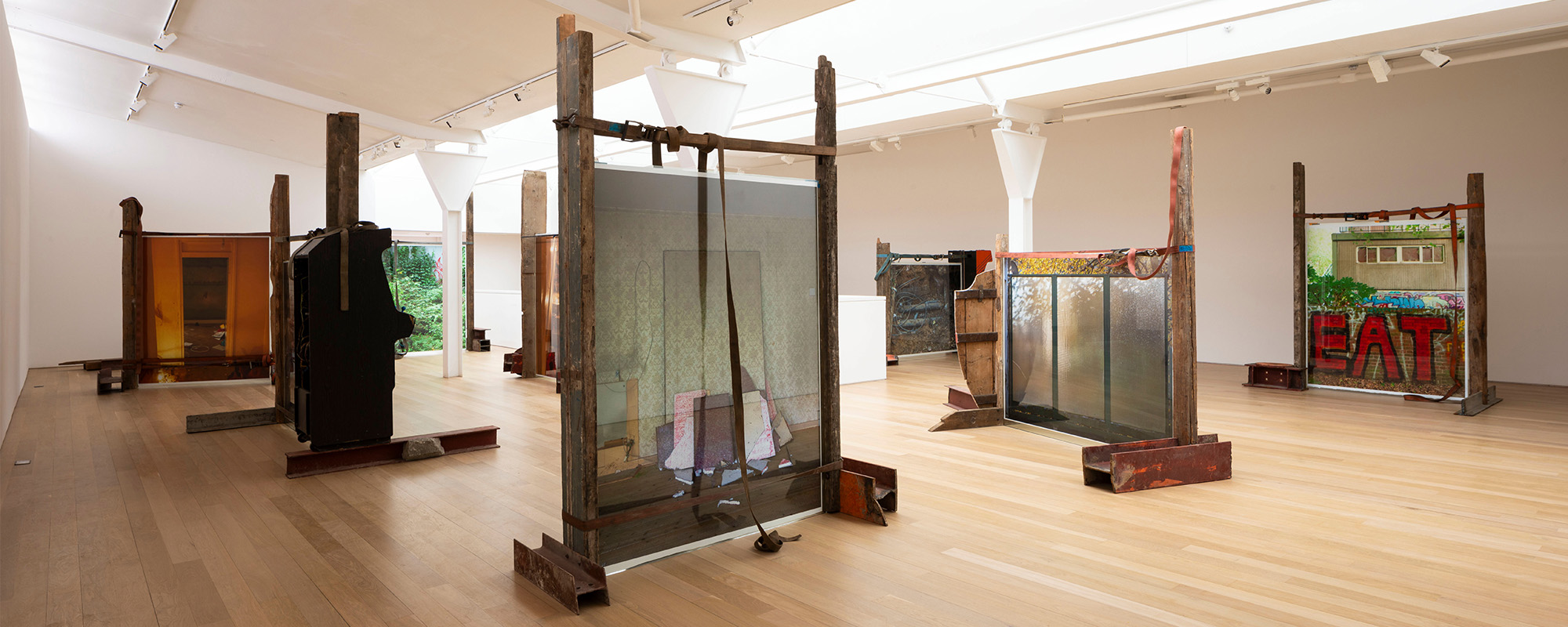
fig.xvi
As well as the Large Glass, they feel to reference Lina Bo Bardi a bit – the architect and who designed the Museu de Arte de São Paulo and its wonderful vitrines, just a sheet of glass held within a lump of concrete, for showing classical paintings. These feel reminiscent, how they're conjoined and clamped. You know how anybody in the artworld visits an exhibition and looks in detail at the frames, and any architect visiting a building looks at all the tiny details and joints – well, with the sculptures, visitors can do both because the frames are architectural joints!
And of course, they're being held up by timbers from, like I said, demolished buildings of my own construction, like from the Biennale, combined with bits of Edinburgh structures as well, like the timbers. And then those girders come from the old Scottish Assembly, which seems apt, like they're trying to hold these things up somehow.And then two large St George crosses, which could seem like something charged or political, what would Scottish visitors make of these?
It was interesting to introduce them, partly because I came to make a show in Scotland and it just seemed quite nice. I saw them at junk shop in Crystal Palace and they kind of stuck with me. I kept looking at them and thought, “nobody's gonna buy them except for me, they're made for me, they're so awkward, difficult.” Then I was thinking of the connection of them between Turkey and the Heygate Estate, because they’re a flag you might see hanging from a window when there’s football or something, but they're also the flags of Crusader who carved up cities in eastern Turkey, so I liked that linkage, so I built them into the into the structures. It's certainly not a declaration of my politics, but it's more the complexity of an image like that. They're big, quite forceful images, probably from the 30s or the 40s and must have been from some theatrical production. And I think they work alongside the video games, because it could become very tasteful otherwise, to suggest a discourse beyond the niceties of timber and the aesthetic of demolished buildings.In many places I see the motif “Home Sweet Home”. It’s on a brass hook and also some graffiti.
It's interesting. It’s like the old Bob Dylan line, “It's not a house, it's a home” and I think that's the thing that always comes back to me with the Heygate – and that's what made it so complicated and why I could understand that people might have a problem with what I was doing there with Artangel. Because generally, we were reconfiguring, we were ripping apart somebody's home – which, of course, was happening anyway, because they were being demolished – but it was that was the complexity that I had to try and navigate to make something empathetic. But, of course, I never got the chance to because it was cancelled.But in a way, you have here to some degree.
It’s very different work, completely different. It might refer back to the history of that work, but this isn't that work? It's almost academic – in fact, somebody's just written a third of their PhD on the Heygate project.It’s one of the many unlived projects. But I guess that is the nature of being an artist, and also in architecture. Anyone who studies architecture, or who knows things that never get built or which have been demolished, walks around a city and they buildings can still be present in the mind. It must be similar as an artist.
It’s like the Heygate project did exist for me. In fact, I argued with Artangel at the end that we should have made a catalogue that documented it as if it did exist.So if a future historian found the book they’d have to piece together whether it did or not actually exist, and look into the rubble of what Elephant Park – what they renamed the Heygate Estate as – will become. As well as this exhibition, Tate Britain, and the Hayward Gallery retrospective, you have constructed a few projects recently: at Matt’s Gallery in London and a show in Parma.
Yes. In Italy, The House of the Farmer was in the Palazzo dell’agricoltore, a Mussolini building. It was a really weird work, like an end-of-COVID work, where it was partly just in, just on the edge of the COVID Stopping, and like it was a privately funded thing. So it's kind of weird – we took an area of land similar scale to the interior of the building and we shipped it in, then made these Cairns, almost treating it like a man made mountain. It became very clearly about the relationship between the rational and irrational, the rationalist architecture and hard plains against almost folkloric, witchcraft-like piles rocks and twisted roots. I didn't quite expect it to be so tangible.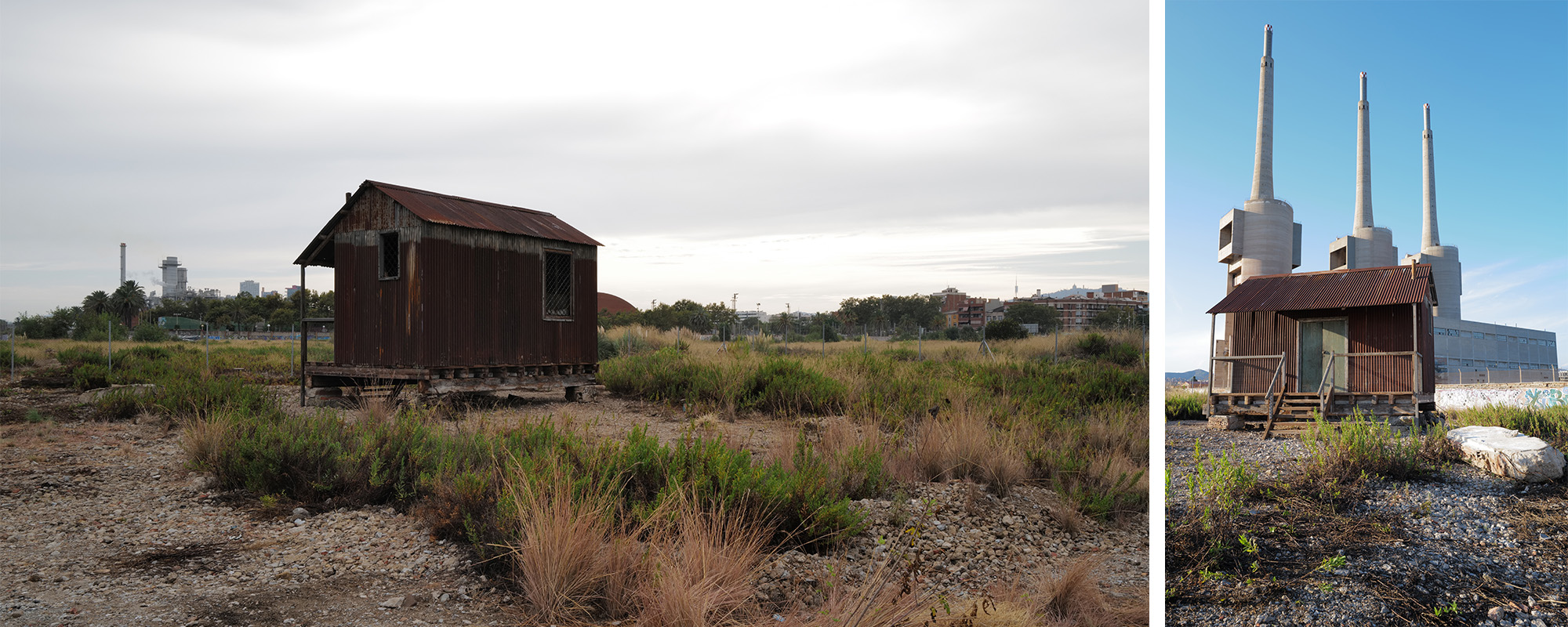
figs.xvii,xviii
And you also made a shed for Manifesta in Barcelona, made of the remnants of demolished buildings and salvaged materials from the industrial site.
That was a beautiful construction. I can't believe they demolished that, for fuck’s sake, I thought they might keep it up there, you know!So when exhibitions finish, you don't return to reclaim all the materials and keep them in your stores any more?
You know the pleasure for this was about a week ago, when I could see it really coming together and making sense. Me and the guys were enjoying making it, Fiona Bradley of the Fruitmarket was enjoying watching it. But now, it's just like, “OK, let's get it open, get over with it and onto the next thing.” I haven’t been home in two months and I have storage problems. I have got a shed full of stuff to ship next month, then another work to install in two weeks.
Mike Nelson (1967) lives and works in
London. His work has centred on the transformation of narrative structure to
spatial structure, and on the objects placed within them, immersing the viewer
and agitating their perception of these environments. The narratives employed by
the artist are not teleological but multi-layered, and often fractured to the
extent that they could be described as a semblance of ‘atmospheres’ put
together to give a sense of meaning. The more discrete sculptural works are
informed by this practice, often relying on their ambiguity to fade in and out
of focus, as a sculpture or thing of meaning, and back to the very objects or
material from which they are made. By working in this way the more overtly
political aspects of the early works have become less didactic, allowing for an
ambiguity of meaning, both in the way that they are experienced and understood.
This has led to the possibility of the viewer being coerced into a state where
the understanding of the varied structures of their existence, both conscious
and sub-conscious, are made tangible. Nelson represented Britain at the Venice
Biennale in 2011 and has twice been nominated for the Turner Prize (2001 &
2007). His critically-acclaimed survey show, Extinction Beckons, at Hayward Gallery (2023) included sculptural
works and new versions of key large-scale installations from the 1990s onwards,
many shown for the first time since their original presentations.
www.mikenelson.org.uk
Will Jennings is a London based writer, visual artist & educator interested in cities, architecture & culture. He has written for Wallpaper*, Canvas, The Architect’s Newspaper, RIBA Journal, Icon, Art Monthly & more. He teaches history & theory at UCL Bartlett & is director of UK cultural charity Hypha Studios.
www.willjennings.info
www.willjennings.info


